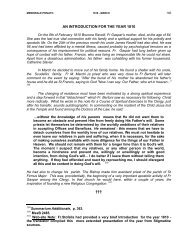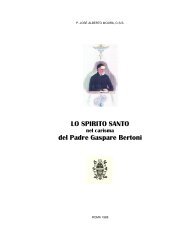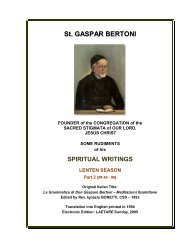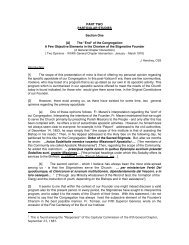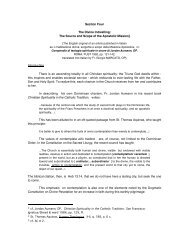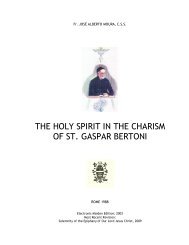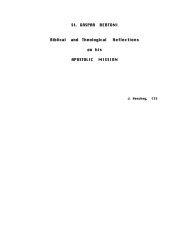A Creative Synthesis of Realism and Hope - St. Gaspar Bertoni
A Creative Synthesis of Realism and Hope - St. Gaspar Bertoni
A Creative Synthesis of Realism and Hope - St. Gaspar Bertoni
Create successful ePaper yourself
Turn your PDF publications into a flip-book with our unique Google optimized e-Paper software.
ST. GASPAR BERTONI<br />
NOVEMBER 4, 1816<br />
A CREATIVE SYNTHESIS OF REALISM AND HOPE<br />
Rev. Joseph Charles Henchey, CSS<br />
October, 2004
November 4, 1816: A <strong>Creative</strong> <strong>Synthesis</strong> <strong>of</strong> <strong>Realism</strong> <strong>and</strong> <strong>Hope</strong> 2 / 18<br />
TABLE OF CONTENTS<br />
Subject<br />
Page<br />
Abbreviations, quotations <strong>and</strong> notes used in this document 3<br />
Introduction 4<br />
A A New Terminology 5<br />
B A Re-newed Mystical ‘Theology’ 8<br />
C The ‘Integral’ <strong>St</strong>igmata <strong>and</strong> the Eternal Espousals 12<br />
Conclusion 16<br />
Endnotes 18
November 4, 1816: A <strong>Creative</strong> <strong>Synthesis</strong> <strong>of</strong> <strong>Realism</strong> <strong>and</strong> <strong>Hope</strong> 3 / 18<br />
ABBREVIATIONS, QUOTATIONS AND NOTES USED IN THIS DOCUMENT<br />
Abbreviation or<br />
Quotation<br />
Meaning<br />
f. (ff.) Follow page(s) or verse(s)<br />
Ibi (or “ib”)<br />
MssB<br />
NB<br />
p. (pp.) Page(s)<br />
Ps (Pss)<br />
Psalms number<br />
It is an abbreviation <strong>of</strong> the Latin “ibidem”, <strong>and</strong> is an editorial<br />
short-cut, which means: there; in the same place.<br />
Manoscritti <strong>Bertoni</strong>ani - all typed in five volumes by Fr. Luigi<br />
Benaglia i , CSS - these are all the writings <strong>of</strong> Fr. <strong>Bertoni</strong> - they<br />
have also been printed out by computer in five volumes with<br />
marginal numbers for easy reference.<br />
NOTA BENE ["note well!"- "pay attention!”- usually used in<br />
English <strong>and</strong> Italian manuscripts - from the Latin]<br />
Psalm(s)<br />
The Psalm number refers always to the Latin Vulgate. When are<br />
quoted two numbers, the second one refers to the modern<br />
Bibles, where the Psalm 9 was divided into two.<br />
q. (qq.) These are abbreviations for: Question/Questions - these are<br />
abbreviations usually used with <strong>St</strong>. Thomas Aquinas.<br />
ss.<br />
Follow pages (or verses) [from the Italian seguenti]<br />
v. (vv.) Verse(s) <strong>of</strong> the Sacred Scripture<br />
Notes<br />
Footnotes<br />
Endnotes<br />
Meaning<br />
Author’s complementary notes regarding terms <strong>and</strong> nouns used<br />
in this document, in numeral sequence (1, 2, 3...), in the same<br />
page (or following), at the bottom.<br />
Author’s complementary notes regarding terms <strong>and</strong> nouns used<br />
in this document, in Roman numeral sequence (I, ii, iii, iv...) at<br />
the end <strong>of</strong> the document.
November 4, 1816: A <strong>Creative</strong> <strong>Synthesis</strong> <strong>of</strong> <strong>Realism</strong> <strong>and</strong> <strong>Hope</strong> 4 / 18<br />
Introduction<br />
[1] It was a time <strong>of</strong> year – almost two centuries ago – when Fr. <strong>Gaspar</strong> <strong>Bertoni</strong>,<br />
Fr. John Mary Marani <strong>and</strong> Bro. Paul Zanoli – the first <strong>St</strong>igmatines – came to live the<br />
beginnings <strong>of</strong> the <strong>St</strong>igmatine life, in the Church <strong>of</strong> the <strong>St</strong>igmata <strong>of</strong> <strong>St</strong>. Francis, in<br />
Verona, Italy. More <strong>and</strong> more the days were shortening – one liturgical year was in<br />
its last weeks – <strong>and</strong> the hours <strong>of</strong> darkness surpassed the hours <strong>of</strong> sun light. These<br />
first three men were soon to be followed by a trickle <strong>of</strong> other men with like-minded<br />
ideals. This event started the Congregation <strong>of</strong> the Sacred <strong>St</strong>igmata <strong>of</strong> Our Lord Jesus<br />
Christ. Their lives were marked with a clear balance between darkness <strong>and</strong> the<br />
hoped-for light <strong>of</strong> a New Advent in their lives, a new beginning – the long winter <strong>of</strong><br />
life, would give way in grace to a renewed spring-time in the Resurrection.<br />
[2] A central inspiration <strong>of</strong> the early <strong>St</strong>igmatines living at the <strong>St</strong>immate ii in<br />
Verona, repeatedly surfacing in the life <strong>of</strong> the Founder would be the Five Wounds <strong>of</strong><br />
Jesus Christ – sorrowfully received on Good Friday with great suffering – <strong>and</strong><br />
gloriously retained in His Risen Body on Easter night, as the Source <strong>of</strong> the Apostolic<br />
Mission. In showing His five wounds, Jesus sent the Apostles on the same Personal<br />
Mission He had eternally received from his Father [cf. Jn 20:21, ff.]. Along with this,<br />
the Community early began to celebrate their Patronal Fest <strong>of</strong> the Holy Espousals <strong>of</strong><br />
Mary <strong>and</strong> Joseph.<br />
[3] One fact above st<strong>and</strong>s out in this history: the <strong>St</strong>igmatine Community has truly<br />
experienced the Sacred <strong>St</strong>igmata in its nearly 200 year life, <strong>and</strong> for more than 99<br />
years in this country: the 'Sorrowful' Good Friday aspect, in the enormous sufferings<br />
the Community has endured - the many pre-mature losses <strong>of</strong> dear <strong>and</strong> competent<br />
men - <strong>and</strong> the failures <strong>of</strong> not a few hopes. The ‘Glorious’, Easter aspect has been<br />
most evident as well: the undying hope in the resurrection, with its extraordinary<br />
commitment to the Apostolic Mission, living out in practice the words <strong>of</strong> Jesus on<br />
Easter night, when He manifested His Sacred <strong>St</strong>igmata in the Cenacle room with this<br />
Apostolic Missionary M<strong>and</strong>ate: As the Father has sent me, I now send you! [cf. Jn<br />
20:19, ff.].<br />
[4] There is a distinct experience we all gain in serving Jesus Christ. This is a<br />
share in His unique relationship with His Father. In his transcription <strong>of</strong> the Meditations<br />
<strong>of</strong> <strong>St</strong>. Gregory the Great preached to the Seminarians <strong>of</strong> Verona commenting on First<br />
Kings [1 S] 1 , the <strong>St</strong>igmatine Founder uses themes that are now quite familiar to us.<br />
1 Fr. <strong>Bertoni</strong> was always most challenging in his ideal for a more than ordinary knowledge<br />
[cf. CF ## 49;50;151]:<br />
5012: There needs to be desires to learn the Science <strong>of</strong> the Saints in order to<br />
convert sinners, to watch over the just, <strong>and</strong> to advance in union with God. [Med 7]
November 4, 1816: A <strong>Creative</strong> <strong>Synthesis</strong> <strong>of</strong> <strong>Realism</strong> <strong>and</strong> <strong>Hope</strong> 5 / 18<br />
Fr. <strong>Bertoni</strong>’s unique bond with Jesus Christ is the source <strong>of</strong> our <strong>St</strong>igmatine Vocation:<br />
seeing the Sacred <strong>St</strong>igmata as our means <strong>of</strong> preparing for the Eternal Nuptials with<br />
the Father, Son <strong>and</strong> Holy Spirit. Fr. <strong>Bertoni</strong> noted this in his Meditations on First<br />
Kings – trials are the source <strong>of</strong> new life:<br />
Med. 6: 4985: But Anna went not up: for she said to her husb<strong>and</strong>: [v. 22].<br />
Anna is invited to share in this solemn oblation, because the holy Church<br />
by the spiritual exhortation <strong>of</strong> her Spouse is enkindled from the daily desires<br />
<strong>of</strong> love to the eternal contemplation <strong>of</strong> divine clarity. 2<br />
Med. 9: 5140: So that the barren has borne many, <strong>and</strong> she that had many<br />
children is weakened. 1 K 2:5.<br />
The weakened one: this is the Synagogue [This is because] by the<br />
institution <strong>of</strong> the old law, it cannot bring to term. For she lost the faith <strong>of</strong> the<br />
first man, <strong>and</strong> this brings forth progeny to the devil, <strong>and</strong> not to God.<br />
She that had many children: Because while she was in the truth <strong>of</strong> the<br />
Scriptures, she brought up the people <strong>of</strong> old subject to her to yearn for the<br />
Advent <strong>of</strong> the coming Redeemer, <strong>and</strong> she brought forth children from her<br />
embrace <strong>of</strong> her Heavenly Spouse.<br />
A. A New Terminology<br />
In order to summarize the one Eternal Word in the most expressive language,<br />
our own times emphasize even the prefixes <strong>of</strong> familiar words: as in Luke’s Gospel<br />
1:35], the Holy Spirit ‘hovers’, over-shadows’ Mary. The Evangelist uses the same<br />
terminology as did the inspired author <strong>of</strong> the original creation story – <strong>and</strong> thus, Jesus’<br />
entire life is IN-spired by the ‘Other’ Paraclete; in Luke’s Gethsemane story [22:44],<br />
we find that Jesus PER-spired His own Precious Blood [… His sweat fell to the<br />
5093: Give us this day our daily bread: Our Bread is Christ. Give us a great<br />
knowledge <strong>of</strong> His excellence, so that we might ever more yearn to serve Him, in<br />
order to be able to know him the better. [Med 8] [With Fr. <strong>Bertoni</strong>’s constant<br />
emphasis on service <strong>of</strong> the Lord, <strong>and</strong> the Church [cf. obsequium], here the<br />
implication is that such total service leads to a kind <strong>of</strong> experience <strong>of</strong> the Lord<br />
[epignosis]<br />
5253: And this is the second benefit <strong>of</strong> temptation, the effect <strong>of</strong> the provident<br />
care <strong>of</strong> the Church, cooperating in the designs <strong>of</strong> the Spouse concerning the care <strong>of</strong><br />
the Elect put to the test, <strong>and</strong> it is the science <strong>of</strong> discretion. The soul, by submitting<br />
itself to the Magisterium <strong>of</strong> the Church acquires this knowledge in temptation, which<br />
reforms the indiscretion <strong>of</strong> desires, while it makes us know our own strengths <strong>and</strong><br />
determines the levels <strong>of</strong> the virtues that we have acquired, after having examined<br />
them as with a touch-stone. What does he know who has not been tried Ecclus 34:9<br />
[Med .12]<br />
2 cf. MssB 4985.
November 4, 1816: A <strong>Creative</strong> <strong>Synthesis</strong> <strong>of</strong> <strong>Realism</strong> <strong>and</strong> <strong>Hope</strong> 6 / 18<br />
ground like great drops <strong>of</strong> blood…] – <strong>and</strong> John [19:30] describes Jesus’ death as an<br />
EX-Spiration, a further sending out <strong>of</strong> the Holy Spirit: [ …<strong>and</strong> bowing His head, He<br />
gave up His Spirit…!] – in preparation for the coming Pentecost.<br />
Our own journey <strong>of</strong> Redemption begins <strong>and</strong> unfolds with our DIS-figuration by<br />
Original <strong>and</strong> our own actual Sin - by God’s Mercy, we are then CON-figured to Christ<br />
Jesus by Baptism, Confirmation <strong>and</strong> the Eucharist [Rm 6] – to be redeemed also by<br />
the TRANS-Figuration <strong>of</strong> Jesus, Who tells us: It was not for my sake that this Voice<br />
[from heaven] came but for yours! [Jn 12:30].<br />
Through long years <strong>of</strong> intense personal suffering before he died, Fr. <strong>Bertoni</strong><br />
became the great prayerful mystic <strong>of</strong> helplessness, under the crucible <strong>of</strong> his terrible<br />
daily monotony. He served God <strong>and</strong> the Church as an invalid for more than 20 years:<br />
the prime <strong>of</strong> his life <strong>and</strong> apostolic productivity were taken from him; his was a near<br />
silver-jubilee <strong>of</strong> an accepted near-solitary confinement, alone day after day with his<br />
thoughts, his intense prayer, <strong>and</strong> his on-going self-giving in behalf <strong>of</strong> God’s People,<br />
as the great Missionary <strong>of</strong> Ab<strong>and</strong>onment to the Paschal Mystery throughout his entire<br />
life. His daily oblation was that <strong>of</strong> routine – he was the Apostle <strong>of</strong> life’s dimness <strong>and</strong><br />
drudgery – as he noted the Church herself lived, which for him was the Model <strong>of</strong> Holy<br />
Ab<strong>and</strong>onment. He once wrote:<br />
… This is the practice <strong>of</strong> the Spouse [<strong>of</strong> Christ] which the Church is. As she<br />
has already been assured by the divine promise <strong>of</strong> the assistance <strong>of</strong> the Holy<br />
Spirit, she does not ever giving up looking for the light in order to continue<br />
her work, or in defending the truth entrusted to her, or restoring discipline.<br />
And when she does see clearly, the Church never gives up working, studying,<br />
consulting, so that she might go proceed further under the light she<br />
receives… 3<br />
He worked always to dissipate the awful dark night <strong>of</strong> the apparent ‘non-sense’ <strong>of</strong><br />
so many years <strong>of</strong> suffering – in the old Latin it could be said <strong>of</strong> <strong>St</strong>. <strong>Gaspar</strong>: his lifejourney<br />
was Per Crucem ad Lucem – Nox illuminatio mea! Knowledge <strong>of</strong> the<br />
Crucified Christ [CF # 51] served as his compass toward the Eternal Nuptials with the<br />
Risen Lord. In addition to his lived balance between suffering <strong>and</strong> healing, between<br />
death <strong>and</strong> hope for a new life, Fr. <strong>Bertoni</strong> believed that his grace <strong>of</strong> commitment – his<br />
self-giving – his self-emptying led to a Holy Ab<strong>and</strong>onment to God, with its ever<br />
greater availability as an oblation for the sake <strong>of</strong> the Church 4 - would lead to<br />
eternal nuptial banquet with the Trinity.<br />
3 Letter 38, October 26, 1813, in: Epistolario, p. 99<br />
4 cf. his Meditation 2 on First Kings:<br />
4891: To adore <strong>and</strong> to <strong>of</strong>fer sacrifice to the Lord God <strong>of</strong> Hosts in Silo. [1 K<br />
1:3].<br />
The Man went up so that he could worship <strong>and</strong> <strong>of</strong>fer sacrifice, because He wanted<br />
to be known for this, that in dying, He would redeem those whom He had taught by<br />
living. He adored: as an example for the chosen, He rendered Himself totally<br />
humble <strong>and</strong> abject through obedience to God the Father. He <strong>of</strong>fered sacrifice, Who
November 4, 1816: A <strong>Creative</strong> <strong>Synthesis</strong> <strong>of</strong> <strong>Realism</strong> <strong>and</strong> <strong>Hope</strong> 7 / 18<br />
The way life is lived, for <strong>St</strong>. <strong>Gaspar</strong>, is the best expression <strong>of</strong> the <strong>St</strong>igmatine<br />
devotions which are always meant to lead to imitation. Giving oneself over to this<br />
ideal is the living out <strong>of</strong> the <strong>St</strong>igmata <strong>of</strong> Christ – <strong>and</strong> this leads to a Holy Espousals,<br />
that will last forever, as the culmination <strong>of</strong> our life-long service <strong>of</strong> God in the Apostolic<br />
Mission – which sometimes will mean lengthy personal suffering. The permanence <strong>of</strong><br />
the marriage <strong>of</strong> Mary <strong>and</strong> Joseph, the ideal <strong>of</strong> all living the Sacrament <strong>of</strong> Holy<br />
Matrimony, served Fr. <strong>Bertoni</strong> also as a sign <strong>of</strong> that eternal nuptials <strong>of</strong> the Saints<br />
with the Father <strong>and</strong> Son <strong>and</strong> Holy Spirit. Fr. <strong>Bertoni</strong> in his Meditations on First Kings<br />
notes that the marriage <strong>of</strong> the Lamb will lead us in the Church to eternal union 5 . As it<br />
by living, <strong>of</strong>fered examples <strong>of</strong> humility, He h<strong>and</strong>ed Himself over to God the Father<br />
on the altar <strong>of</strong> the Cross as an oblation <strong>and</strong> a host 4 , <strong>and</strong> those whom he taught by<br />
living, He redeemed by dying.<br />
4894: Third Means: the Ministry <strong>of</strong> Priests …<br />
In Silo v. 3. This is the place <strong>of</strong> the immolation.<br />
Silo: the word means “sent”, or is interpreted “mission”, indicating the imposed<br />
precept <strong>of</strong> the supreme Father, <strong>of</strong> obedience on His Only-Begotten.<br />
To <strong>of</strong>fer sacrifice in Silo: Because Christ in no other way gave Himself over to<br />
death than being sent by the Father. Jn 14:31: As the Father has given Me<br />
comm<strong>and</strong>ment, so do It.... - Ph 2:8: …becoming obedient unto death, even to the<br />
death <strong>of</strong> the Cross....<br />
In Silo, he adored <strong>and</strong> <strong>of</strong>fered sacrifice, because both in living as in dying, He did<br />
the Father’s Will.<br />
[Fr. <strong>Bertoni</strong> took his central ideal from this view: Christ <strong>of</strong>fering Himself as an oblation<br />
rendered by the obsequium [cf. Rm 12:1] – this ideal is found in a number <strong>of</strong> Fr. <strong>Bertoni</strong>’s<br />
Original Constitutions: [## 1; 7; 57; 62; 125; 185; 195; 237; 296; 304]. This revealed data<br />
<strong>of</strong> Jesus’ being sent by the Father, [Jn 14:3] is behind all Mission in the Church – <strong>and</strong><br />
certainly is the heart <strong>of</strong> Fr. <strong>Bertoni</strong>’s Trinitarian charism <strong>of</strong> <strong>Hope</strong>. At <strong>St</strong>. Joseph’s Convent,<br />
Verona, he saw a painting <strong>of</strong> the Trinity, <strong>and</strong> noted that this explained to him Divine Mercy –<br />
with the Father’s ready communication <strong>of</strong> his gifts [cf. MP, Aug. 24, 1808. [cf. <strong>Bertoni</strong> Web-<br />
Site, under ‘<strong>St</strong>udies, The Trinitarian Charism <strong>of</strong> <strong>Hope</strong>. cf. below].<br />
5 Vocation in the Church is life-long preparation, living <strong>of</strong> the <strong>St</strong>igmata:<br />
Med.6: 4905: I am black but beautiful [Ct 1:4]. Do not consider me, that I am<br />
brown, because the sun has altered my color. [ib., v. 5]. - Solomon’s temple was<br />
built without noise [3 K 6:7]. – For the marriage <strong>of</strong> the Lamb has come <strong>and</strong> his wife<br />
has prepared herself. And it is granted to her that she should clothe herself with fine<br />
linen, glittering <strong>and</strong> white. For the fine linen is the justification <strong>of</strong> saints…. [Apoc<br />
19:7, ff.].<br />
[The Wounded Lamb takes the Church as His Bride – for Fr. <strong>Bertoni</strong>, the Church is the<br />
Spouse <strong>of</strong> Christ, is the Model <strong>of</strong> Holy Ab<strong>and</strong>onment cf. the Web-Site, under Translations,<br />
that <strong>of</strong> Fr. Nello Dalle Vedove’s Doctoral Thesis, bearing this title].
November 4, 1816: A <strong>Creative</strong> <strong>Synthesis</strong> <strong>of</strong> <strong>Realism</strong> <strong>and</strong> <strong>Hope</strong> 8 / 18<br />
is said that asceticism divides to conquer – as the old Imitation <strong>of</strong> Christ would<br />
remind us: if we were to gain one virtue a year, if we lived long enough we would be<br />
holy. The mysticism <strong>of</strong> the saints, then, through charity unites, ‘in-forms’ all that we<br />
are meant to be <strong>and</strong> to do.<br />
To reach his synthesis, Fr. <strong>Bertoni</strong> was much inspired by the Scriptures: all<br />
theological students know that the heart <strong>of</strong> all our studies is a proper, Churchcentered<br />
EX-egesis, avoiding all EIS-egesis [a personal, subjective reading into<br />
God’s Word]. The saints teach us a genuine IN-egesis, as an on-going process <strong>of</strong><br />
finding Christ IN every verse. For the saints, the Divine Inspiration <strong>of</strong> God’s Word is<br />
not comparable to His employing passive musical instruments to produce His<br />
symphony <strong>of</strong> truth – or inert paint brushes [as these can only produce a work <strong>of</strong> art,<br />
the closer they are to the h<strong>and</strong> <strong>and</strong> heart <strong>of</strong> the Divine Artist]. Rather, the <strong>Creative</strong><br />
God, sanctifying humanity with His redemptive word, inspired the artists <strong>of</strong> human<br />
language to express Divine Truth, in both word <strong>and</strong> deed, through charisms lived in<br />
the Church. The Bible for <strong>St</strong>. <strong>Gaspar</strong> is a symphony <strong>of</strong> truth <strong>of</strong> the Old <strong>and</strong> New<br />
Testaments; the harmony between history <strong>and</strong> prophecy; there is divine blending<br />
found in the Gospels <strong>and</strong> the Epistles; an integration <strong>of</strong> the Wisdom Tradition <strong>and</strong> the<br />
Apocalypse. Fr. <strong>Gaspar</strong> was much nourished by the dry grains <strong>of</strong> wheat – <strong>and</strong><br />
refreshed by the sour grapes <strong>of</strong> life then consecrated into the Precious Body <strong>and</strong><br />
Blood <strong>of</strong> the Risen Lord in the Eucharist.<br />
B. A Re-newed Mystical ‘Theology’<br />
<strong>St</strong>. <strong>Gaspar</strong> would notice not only Scripture <strong>and</strong> nature, but sacred art as well to<br />
express his ideal. He noted this early in his Spiritual Diary one late summer night:<br />
…This evening I saw a painting that depicted an image <strong>of</strong> the Trinity, that<br />
inspired much reverence <strong>and</strong> love in me for the three Persons. The eternal<br />
4980: …She named him Samuel. v. 20.<br />
Those whom He justified, those He also glorified [Rm 8:30], in this life, the<br />
militant Church, symbolizes the triumphant Church, as the Synagogue symbolized<br />
the militant Church. He glorified with the name, with the gifts <strong>and</strong> with the infused<br />
virtues, with merits.<br />
God gives to those whom He calls to any given state whatever is necessary for<br />
that state <strong>of</strong> life. Therefore, God has done much for His own. The Church, too, His<br />
Bride, we will see that she is not lacking in her own prudent <strong>and</strong> provident<br />
commitment.<br />
[In his very important CF # 185 <strong>of</strong> the Original Constitutions, Fr. <strong>Bertoni</strong> makes clear that the<br />
difficult <strong>and</strong> arduous vocation <strong>of</strong> the <strong>St</strong>igmatine is not based on human strength, but on the<br />
grace <strong>of</strong> the Holy Spirit, who has begun <strong>and</strong> inspired this good work [cf. Ph 1:6], <strong>and</strong> He will<br />
bring it to perfection if He is not hindered in this by us; for this is the special grace <strong>of</strong> this<br />
vocation…].
November 4, 1816: A <strong>Creative</strong> <strong>Synthesis</strong> <strong>of</strong> <strong>Realism</strong> <strong>and</strong> <strong>Hope</strong> 9 / 18<br />
Father as st<strong>and</strong>ing with His arms opened which explained for me something<br />
<strong>of</strong> His Mercy <strong>and</strong> his ready communication <strong>of</strong> His gifts… 6<br />
<strong>St</strong>. <strong>Gaspar</strong> also saw his own vocation as that <strong>of</strong> drawing within himself a portrait <strong>of</strong><br />
Jesus Christ:<br />
… We need to draw a portrait within ourselves <strong>of</strong> Jesus Christ… 7<br />
Fr. <strong>Bertoni</strong> develops this in his beautiful Original Constitution 223:<br />
For indeed nothing moves one toward that love <strong>of</strong> genuine charity for another<br />
than for us to take note <strong>of</strong> those singular ornaments <strong>of</strong> virtues <strong>and</strong> gifts <strong>of</strong> the<br />
Holy Spirit in him, <strong>and</strong> that we contemplate the other as an Image <strong>of</strong> God<br />
painted with the most excellent colors <strong>of</strong> grace. If, therefore, all strive to<br />
increase within themselves in those virtues <strong>and</strong> graces that they frequently<br />
reflect on in others, <strong>and</strong> that they come to consider these others are superior<br />
to ourselves [cf. Ph 2:3], <strong>and</strong> to rejoice in those spiritual goods <strong>of</strong> others, <strong>and</strong><br />
to thank God for them, then in a marvelous manner will mutual charity<br />
increase in them.<br />
At the end <strong>of</strong> the last General Chapter held in Rome, the Capitulars were blessed at<br />
an Audience with Pope John Paul IInd. In thanking our small Congregation for its<br />
relatively high number <strong>of</strong> confreres chosen to be Bishops – the Holy Father quoted<br />
this Original Constitution - clearly based on CSJ 250 <strong>of</strong> <strong>St</strong>. Ignatius <strong>of</strong> Loyola, <strong>and</strong><br />
the great Jesuit Theologian Francis Suarez 8 . Fr. Suarez noted other sources for this<br />
thought going back to the Rule <strong>of</strong> <strong>St</strong>. Augustine, <strong>and</strong> even to <strong>St</strong>. Paul, who wrote in<br />
captivity to the Philippians: be united in your convictions, united in your love …<br />
be self-effacing. Always consider the other person to be better than yourself…<br />
[cf. Ph 2:2, ff.]. This serves as Paul’s introduction <strong>of</strong> the central mystery <strong>of</strong> Christ’s<br />
self-emptying. It is in His Divine Filiation that the Son loves the Father – <strong>and</strong> in Fr.<br />
<strong>Bertoni</strong>’s ideal it is fraternal love <strong>and</strong> humility that the <strong>St</strong>igmatine comes best to<br />
imitate Him. [CF ## 188; 208; 220].<br />
The Irish Monk, Dom Columba Marmion, OSB, was beatified with Blessed<br />
Pope John 23 rd . As one incardinated into the Arch-Diocese <strong>of</strong> Dublin, he was<br />
ordained in our own <strong>St</strong>igmatine Church, <strong>St</strong>. Agatha <strong>of</strong> the Goths, in Rome, Italy. He<br />
once wrote:<br />
…’leave your <strong>of</strong>fering before the altar, <strong>and</strong> go first to be reconciled to your<br />
brother…’ [Mt 5:23, f.]. This is why the least willful coldness, the last<br />
resentment harbored in the soul towards our neighbors form a great obstacle<br />
6 cf. MP, Aug. 24, 1808.<br />
7 cf. MP, Feb. 26, 1809<br />
8 F. Suarez, SJ, Tractatus Decimus. De Religione Societatis Iesu, Book 8, c. 8, n. 1, p. 955 a.<br />
[NB: The first <strong>St</strong>igmatine Mission is one’s own confreres – cf. CF # 262]
November 4, 1816: A <strong>Creative</strong> <strong>Synthesis</strong> <strong>of</strong> <strong>Realism</strong> <strong>and</strong> <strong>Hope</strong> 10 / 18<br />
to the perfection <strong>of</strong> that union which Our Lord wishes to have with us in the<br />
Eucharist… 9<br />
Fr. <strong>Bertoni</strong> lamented that there are only very few who grasp what God would<br />
accomplish in them, if He was not impeded by them. 10 The German Protestant<br />
theologian Jurgen Moltmann noted that the original sin is not so much the titanic<br />
desire to be like God – but, rather the refusal to be what God likes!<br />
The ultimate Model for <strong>St</strong>. Paul’s ideal is Jesus Christ - who emptied himself<br />
[the Greek word is kenosis] to become one <strong>of</strong> us – so that as He became poor for<br />
our sake, we might become enriched by His poverty [cf. 2 Co 8:9]. Christ’s great<br />
wealth is that He is the Incarnation <strong>of</strong> His Father’s Mercy, as Pope John Paul II<br />
describes so beautifully in his encyclical <strong>of</strong> the First Sunday <strong>of</strong> Advent, 1980, Dives<br />
in Misericordia.<br />
The Kenosis: self-emptying <strong>of</strong> Jesus Christ is the ICON <strong>of</strong> the invisible God<br />
[cf. Col 1:15] – Jesus by giving Himself is the radiant light in our darkness <strong>of</strong> God’s<br />
glory, <strong>and</strong> the perfect copy [karakter] <strong>of</strong> His nature [cf. Heb 1:3] – whoever sees<br />
Jesus sees also the eternal Trinity: whoever sees Me, sees the One Who sent<br />
Me [cf. Jn 12:44, ff] – To have seen Me, is to have seen the Father [cf. Jn 14:7-9].<br />
The Sacred <strong>St</strong>igmata <strong>of</strong> Jesus Christ, then, is the Window allowing us to look into the<br />
Trinity – <strong>and</strong> the Mirror before which we are called by vocation to st<strong>and</strong> to see if we<br />
are truly ready for the Nuptial Banquet <strong>of</strong> the Eucharist, <strong>and</strong> the Eternal Espousals<br />
with God, Father, Son <strong>and</strong> Holy Spirit.<br />
A great modern theologian [Fr. von Balthasar] has taught that within the<br />
Trinity, the divine Persons are constituted by their self-giving – a ‘Person’ within the<br />
Trinity is One Who gives <strong>of</strong> Himself to the Others. Jesus’ <strong>St</strong>igmata is the culmination<br />
<strong>of</strong> His Self-giving earth - <strong>and</strong> enables Him to be the Immolated Lamb <strong>of</strong> the special<br />
marriage noted near the end <strong>of</strong> Sacred Scripture: there will be a New Heaven <strong>and</strong> a<br />
New Earth. Forever, He will be our God <strong>and</strong> we will be His People – a nuptial<br />
formula. He will wipe away all tears from our eyes - there will be no more death, no<br />
more mourning, no more separation, no more sadness! [cf. Rv 21:1, ff.] – the Church<br />
will be all dressed up as a Bride with the good deeds <strong>of</strong> the Saints for her Espousals<br />
with the Immolated Lamb! Fr. <strong>Bertoni</strong> uses phrases from the Song <strong>of</strong> Songs to<br />
describe [with <strong>St</strong>. Gregory] this mysterious attraction for the Eternal Espousals:<br />
Med. 7: 5004: Prelude 3. Draw me after You [Ct 1:3] You draw, O Lord, Your<br />
Spouse by Your right h<strong>and</strong>, <strong>and</strong> we will run after You to the odor <strong>of</strong> Your ointments:<br />
9 Dom Columba Marmion, ‘Christ, the Life <strong>of</strong> the Soul’, 5 [CLS 2, 8, 5], in: Spiritual<br />
Writings. P. Lethielleux-Mardesus Abbey 1998, p. 236 [NB: <strong>St</strong>. Agatha <strong>of</strong> the Goths Church<br />
in Rome has been the <strong>St</strong>igmatine General Curia in Rome since 1927 – from 1837-1927, it<br />
served as the Irish College <strong>and</strong> a Priest <strong>of</strong> Dublin – Dom Columba Marmion, was ordained<br />
there in June 1881, by the Rector, Bishop Kirby.<br />
10 cf. MP, May 18, 1811. cf. also Letter 19, Feb. 1813, Epistolario pp. 61, f.; Letter 80, ib., p.<br />
166; Letter 154, March 28, 1829, p. 254.
November 4, 1816: A <strong>Creative</strong> <strong>Synthesis</strong> <strong>of</strong> <strong>Realism</strong> <strong>and</strong> <strong>Hope</strong> 11 / 18<br />
ibi, <strong>and</strong> the teachings <strong>of</strong> the Church in words <strong>and</strong> deeds <strong>and</strong> disciplines: in<br />
the odor <strong>of</strong> Your ointments” this is the fruit <strong>of</strong> Your grace. To the odor <strong>of</strong> Your<br />
ointments Ct 1:3. And if we cannot follow you with a strong love <strong>of</strong> a Spouse<br />
already adult in the school <strong>of</strong> holy love draw me ibi. We will follow you with<br />
the first-fruits <strong>of</strong> the most tender, nascent <strong>and</strong> youthful fervor.<br />
Med. 7: 5005: We will run after you to the odor <strong>of</strong> your ointments Ct 1:3. Therefore,<br />
the young maidens have loved you v. 2.<br />
O Lord, you draw everything to the designs <strong>of</strong> Your Providence with the<br />
sweetness <strong>and</strong> effectiveness <strong>of</strong> Your grace, the precious fruit <strong>of</strong> Your House.<br />
And I, if I be lifted up from the earth, will draw all things to Myself. [cf. Jn 12:32].<br />
Thus, You draw Your Spouse, which is the Church, our Mother, <strong>and</strong> Yours <strong>and</strong><br />
her children, which we also are.<br />
Med. 7: 5006: But, Your Spouse You draw as it were, by the h<strong>and</strong>, by Your<br />
right h<strong>and</strong>, <strong>and</strong> so she does not so much follow You, as accompany You: draw<br />
me Ct 1:3. Thus, you divide as though with your maternal care the execution <strong>of</strong><br />
your paternal Providence over us. We, as your tender young children, cannot<br />
run with You, as You go not with steps, but with leaps, <strong>and</strong> leaps <strong>of</strong> a giant:<br />
He has rejoiced as a giant to run the way [Ps 18:6], We too will run after You -<br />
We will run after You ibi, in the odor <strong>of</strong> Your graces: to the odor <strong>of</strong> Your ointments<br />
ibi, <strong>and</strong> <strong>of</strong> the teachings, <strong>and</strong> disciplines, <strong>and</strong> <strong>of</strong> the examples <strong>of</strong> our Mother,<br />
<strong>and</strong> these are also Your graces. 11<br />
This is the divinely chosen Descent <strong>of</strong> God – so that we might go back through<br />
the Ascension, to be with Him forever in our resurrection. Theology speaks <strong>of</strong><br />
Christology from Above – with the Descent <strong>of</strong> Christ among us at Christmas. The<br />
counter-part <strong>of</strong> this is the Christology from below: that the Lord ascends from His<br />
earthly sojourn for the eternal bliss <strong>of</strong> the Church with the Trinity. The Saints – as Fr.<br />
<strong>Bertoni</strong> does – teach us a Christology from Within! 12<br />
The Saints came to underst<strong>and</strong> the IN-spiration <strong>of</strong> God’s Word, the INfusion<br />
<strong>of</strong> God’s Grace, that the Risen Christ IN-forms the Eucharist <strong>and</strong> those<br />
who receive It – in differing ways, as we are IN-grafted into Christ at Baptism, we are<br />
IN-undated by His Holy Spirit at Confirmation, we are IN-corporated into Him by the<br />
reception <strong>of</strong> Holy Communion. In the sufferings <strong>of</strong> life, there develops a kind <strong>of</strong><br />
nuptial pattern: our adoring <strong>and</strong> praying saintly Founder discerned that within, a new<br />
life, a new <strong>and</strong> fresh charism that came forward for the Church. Authentic spirituality<br />
involves a sharing in Christ’s Holy Ab<strong>and</strong>onment to His Father – <strong>and</strong> each <strong>of</strong> us<br />
is called to share in this as we accept the way life turns out. Our vocation is a<br />
persevering fidelity to Christ’s <strong>St</strong>igmata, the ultimate expression <strong>of</strong> His self-giving –<br />
11 These thoughts are from Meditation 7. Fr. <strong>Bertoni</strong> uses this same expression in his<br />
gradated ‘Espousals Principle’ - cf. his Panegyric on <strong>St</strong>. Francis <strong>of</strong> Assisi, perhaps the<br />
morning <strong>of</strong> the Feast October 4, 1808 [cf. MssB ## 144-1874, especially # 1868].<br />
12 For these thoughts, cf. Mark A. MacIntosh, Spirituality <strong>and</strong> the Incarnation in Hans Urs<br />
von Balthasar. Notre Dame & London: University <strong>of</strong> Notre Dame Press 1966.
November 4, 1816: A <strong>Creative</strong> <strong>Synthesis</strong> <strong>of</strong> <strong>Realism</strong> <strong>and</strong> <strong>Hope</strong> 12 / 18<br />
that will be blessed eternally with an espousals forever with God. The saints provide<br />
a marvelous synthesis regarding the presence <strong>of</strong> the Suffering <strong>and</strong> Risen Christ<br />
within us all – for Fr. <strong>Bertoni</strong>, the acceptance <strong>of</strong> God’s will is the ultimate living <strong>of</strong> the<br />
<strong>St</strong>igmatine life – configuration to Christ means to share His experience. As Christ<br />
has risen, He is present in all <strong>of</strong> the segments <strong>of</strong> life: the past, this very day <strong>and</strong> the<br />
unknown tomorrow. This is kept before us in the Eucharist as Memorial, Presence<br />
<strong>and</strong> Promise. The saints more than anyone provide a tangible witness <strong>of</strong> Christ’s life,<br />
death <strong>and</strong> resurrection.<br />
C. The ‘Integral’ <strong>St</strong>igmata <strong>and</strong> the Eternal Espousals<br />
As Jesus died totally divested <strong>of</strong> His external glory, in deepest darkness <strong>and</strong><br />
shame, can we in some way imagine Fr. <strong>Bertoni</strong>’s hope as a Founder flickering as<br />
long as he lived, <strong>and</strong> never being extinguished He truly was caught up in Jesus’<br />
own loving obedience, His ab<strong>and</strong>onment to his Father. There is a growth for the<br />
Church in the underst<strong>and</strong>ing <strong>of</strong> God’s word, the Council teaches us [DV 8] through<br />
contemplation, study, lived experience <strong>and</strong> fidelity to the teaching Church: this seems<br />
to be a synthesis <strong>of</strong> Fr. <strong>Bertoni</strong>’s life. There is a deep divine fuller sense in God’s<br />
Word – for <strong>St</strong>. <strong>Gaspar</strong>, trusting in God: his style <strong>of</strong> Holy Ab<strong>and</strong>onment to God’s Will<br />
was a translation <strong>of</strong> years <strong>of</strong> poor health, sadness at home, family struggles, some<br />
apostolic failures, <strong>and</strong> community difficulties – <strong>and</strong> then in death in itself. In coping<br />
with the challenges <strong>of</strong> is life, Fr. <strong>Bertoni</strong> was gradually forged into preparation for<br />
eternity.<br />
Scripture refers to the nothingness before creation as an abyss <strong>of</strong> the<br />
darkness, the desert <strong>and</strong> the deep – <strong>and</strong> this abyss <strong>of</strong> human misery calls out to the<br />
abyss <strong>of</strong> Infinite Mercy<br />
13 . Jesus bestows on those dearest to him an increasing<br />
share in His Sacred <strong>St</strong>igmata – in all <strong>of</strong> this suffering, the Eucharist provides the<br />
Nuptial Banquet leading to the eternal life <strong>of</strong> union.<br />
Corresponding to the life <strong>of</strong> Grace in the crucible <strong>of</strong> his own personal suffering<br />
<strong>and</strong> dedication to the changing needs <strong>of</strong> the Church, <strong>St</strong>. <strong>Gaspar</strong> developed in his<br />
self-ab<strong>and</strong>onment to God <strong>and</strong> availability to the Church. He saw it as a gradual<br />
clarifying <strong>of</strong> the portrait <strong>of</strong> Christ Jesus within his own life. Through the <strong>St</strong>igmata <strong>of</strong><br />
his own life – so <strong>of</strong>ten wounded, but not dead! - he is brought beyond his own<br />
limitations to this in-depth experience <strong>of</strong> God’s Self-giving, <strong>and</strong> an experience <strong>of</strong><br />
Christ’s Passion <strong>and</strong> Death. This was one <strong>of</strong> his avowed purposes in preaching – to<br />
lead his listeners to come to the clefts <strong>of</strong> the <strong>St</strong>igmata:<br />
13 Fr. <strong>Bertoni</strong> <strong>of</strong>ten refers to this abyss in his Letters to Mother Naudet – cf. Epistolario:<br />
Letter 8, Dec. 1812, p.40; Letter 48, June 1814 p. 115
November 4, 1816: A <strong>Creative</strong> <strong>Synthesis</strong> <strong>of</strong> <strong>Realism</strong> <strong>and</strong> <strong>Hope</strong> 13 / 18<br />
430: Show, therefore, to these souls who devoutly gaze upon you those<br />
cruel clefts <strong>of</strong> those nails made in you, first lacerating His h<strong>and</strong>s, <strong>and</strong> then His<br />
feet. Show the very place where His head reclined upon you, expiring, as their<br />
loving Father, indeed their faithful Friend, their most tender Brother, their<br />
most lovable <strong>and</strong> most kind Spouse. Lastly, show that blood shed out <strong>of</strong> love<br />
for them, with which you still trickle <strong>and</strong> redden in long streams. In addition to<br />
the impression that you can bring about in them, let there be joined also the<br />
eloquence <strong>of</strong> this blood, as the Apostle describes [Heb 12:24]. Let there be<br />
attained, therefore, through you such a great commotion in the hearts <strong>of</strong> these<br />
listeners that I believe I will see this very day, even though I cannot achieve<br />
this with my words 14 .<br />
In his own mysticism <strong>of</strong> helplessness associated with the wounds <strong>of</strong> life, Fr.<br />
<strong>Bertoni</strong>’s hope never wavered in the special grace <strong>of</strong> the vocation - one that is not<br />
based on human resources, but is to be carried out with the grace <strong>of</strong> the Holy<br />
Spirit, for ‘He Who has begun a good work in you will bring it to perfection’ [Ph<br />
1:6] [cf. CF # 185].<br />
The deep trials that <strong>St</strong>. <strong>Gaspar</strong> experienced with his health <strong>and</strong> mission were<br />
not an interruption in his life <strong>of</strong> prayer – but, rather a means that brought to an ever<br />
greater sharing in Christ’s death <strong>and</strong> resurrection. In all his times <strong>of</strong> darkness, <strong>St</strong>.<br />
<strong>Gaspar</strong> went on searching, seeking for the Lord in all things: seek God alone, for to<br />
see God in all things, this is a making <strong>of</strong> oneself superior to all human<br />
happenings 15 - reading today about the internal presence <strong>of</strong> God, i.e., that<br />
since God is within us, it is not necessary to go outside to look for Him 16 - God<br />
alone is to be sought, <strong>and</strong> nothing else: not consolations or satisfactions 17 .<br />
This is the marked contrast: …in the depths <strong>of</strong> one’s own nothingness, God is<br />
found. Experiencing very sublime realities concerning God, there was a<br />
pr<strong>of</strong>ound recognition <strong>of</strong> myself. 18<br />
In the mystical style <strong>of</strong> Fr. <strong>Gaspar</strong>, he <strong>of</strong>ten expresses himself in terms taken<br />
from his reflections on the <strong>St</strong>igmata, <strong>and</strong> on God the Spouse <strong>of</strong> the soul, or, Christ<br />
the Spouse <strong>of</strong> the Church 19 :<br />
4991: Regarding prayer, she feeds him having him meditate on the<br />
mysteries <strong>of</strong> His humanity; she feeds him making him meditate on His<br />
Passion; she brings him to the temple, making him meditate on the mysteries<br />
14 This is from <strong>St</strong>. <strong>Gaspar</strong>’s Good Friday sermon <strong>of</strong> 1801 – then repeated in 1806.<br />
15 cf. MP, July 30, 1808<br />
16 cf. MP, Oct. 13, 1808<br />
17 cf. MP, Dec. 23, 1808.<br />
18 cf. MP, Aug. 24, 1808.<br />
19 Cf. Meditation 6
November 4, 1816: A <strong>Creative</strong> <strong>Synthesis</strong> <strong>of</strong> <strong>Realism</strong> <strong>and</strong> <strong>Hope</strong> 14 / 18<br />
<strong>of</strong> the resurrection <strong>and</strong> the divinity, so that he can then preach with unction,<br />
etc. 20<br />
We should correspond also in action, progressing from virtue to virtue, [Ps<br />
83:8], from the moral virtues to the religious, to the divine; <strong>and</strong> in prayer<br />
seeking to pr<strong>of</strong>it from the life <strong>of</strong> Christ, to His Passion <strong>and</strong> to His<br />
Resurrection. Accomplishing all this methodically, <strong>and</strong> not by fits <strong>and</strong> starts.<br />
All is based on the divine Scriptures, from which one derives precepts for<br />
action, <strong>and</strong> knowledge for prayer. All prayer, all scripture, inspired <strong>of</strong> God, is<br />
pr<strong>of</strong>itable to teach, to reprove, to correct, to instruct in justice.... [2 Tm 3:16, f.].<br />
The mystical ‘Night’ assumes many forms – a kind <strong>of</strong> absence <strong>of</strong> the ‘Omnipresent’;<br />
or silence <strong>of</strong> the Eternal Word; the ‘darkness’ <strong>of</strong> Christ’s descent; the Psalmist’s<br />
‘desert thirst’ for the streams <strong>of</strong> Salvation [cf. Pss 22; 42; 63 – Is 12:1, ff.], for God;<br />
the biblical descriptions <strong>of</strong> Gethsemane or the Paschal Mystery in general. For <strong>St</strong>.<br />
<strong>Gaspar</strong>, his long <strong>and</strong> painful monotony <strong>of</strong> sacrifice led him ever more deeply into the<br />
mystery <strong>of</strong> the spirit <strong>of</strong> Holy Ab<strong>and</strong>onment. The mystery <strong>of</strong> the <strong>St</strong>igmata is not only<br />
loved – <strong>and</strong> learned about – but needs to be experienced in the School <strong>of</strong> God. In<br />
describing his healing process as wounded, but not dead, Fr. <strong>Bertoni</strong> wrote to Mother<br />
Naudet:<br />
... I am getting better rather slowly! Please pray, Reverend Mother, out<br />
<strong>of</strong> your charity, that I may derive some fruit from the school in which He<br />
has deigned to teach me, so that I might be disposed to serve Him… 21<br />
Years later, <strong>St</strong>. <strong>Gaspar</strong> saw his own long ‘dark night’ as the privileged time in<br />
which to learn in the School <strong>of</strong> God:<br />
…The works <strong>of</strong> God have their own trials, with which God shows his<br />
own h<strong>and</strong> in directing them <strong>and</strong> leading them to His purposes. He does<br />
this with the difficulties which He allows, by taking our cooperation<br />
away, that we might give space to His Providence. From this the way<br />
can be seen clearly that all depends on His conservation <strong>and</strong> granting<br />
success. When, therefore, it is night for us, it is the day-time for Him.<br />
He is the One Who knows what is to be done. And we ought to raise our<br />
h<strong>and</strong>s toward heaven, when we do not know how to apply them, <strong>and</strong><br />
thus it is better that we ask the outcome <strong>of</strong> God. ‘In the nights lift up<br />
your h<strong>and</strong>s to the holly laces, <strong>and</strong> bless the Lord.’ [cf. Ps 133:2]. This is<br />
the Latin that God teaches to anyone who is in His School. ‘And the<br />
night shall be light as the day.’ [Ps 138:12] And this is a further Latin<br />
20 Translator’s Note: <strong>St</strong>. <strong>Gaspar</strong> notes here the need to meditate on the Resurrection, in order<br />
to preach with more unction. In Fr. <strong>Bertoni</strong>’s retreat for young priests [September 13-22,<br />
1801], Fr. <strong>Bertoni</strong> developed both aspects <strong>of</strong> the <strong>St</strong>igmata: Imagine that you see Him with the<br />
scars <strong>of</strong> his wounds… inviting you, too, to heaven…Christ has entered new life with the scars<br />
<strong>of</strong> His wounds… [cf. MssB ## 2632; 2635-2647, passim.] [cf. also the website: www.stbertoni.com,<br />
under “<strong>St</strong>udies”, STIMMATE INTEGRE].<br />
21 cf. Letter 45, June 1, 1814, in Epistolario, p. 109.
November 4, 1816: A <strong>Creative</strong> <strong>Synthesis</strong> <strong>of</strong> <strong>Realism</strong> <strong>and</strong> <strong>Hope</strong> 15 / 18<br />
principle that our good Father has explained to us from the very<br />
beginning, drawing the light out <strong>of</strong> the darkness, <strong>and</strong> that He would<br />
like, out <strong>of</strong> His goodness, to clarify subsequently, as the darkness<br />
returns. It is in this that He leaves our works, for the admirable splendor<br />
<strong>of</strong> His glory. ‘Trust in the Lord’, therefore, ‘<strong>and</strong> do good!’ [Ps 36:3]. 22<br />
As actions speak louder than words, the love <strong>of</strong> Fr. <strong>Bertoni</strong>’s heart moved him<br />
to ab<strong>and</strong>on his cares into the arms <strong>of</strong> God’s loving mercy – <strong>and</strong> to commit every fiber<br />
<strong>of</strong> his strength to the service <strong>of</strong> the Church. The deepest wounds <strong>of</strong> love in Christ are<br />
the signs <strong>of</strong> His immolation endured on the Cross, the final one being inflicted even<br />
after his death – leading to an eternal espousals:<br />
Med. 3: 4899: …The fourth means: He governs her with the gifts <strong>of</strong> His<br />
grace <strong>and</strong> glory. The charity <strong>of</strong> God is poured forth... [Rm 5:5]. - For we are saved<br />
by hope. [Rm 8:24]. Such gifts had been merited with the Passion,<br />
communicated in the Resurrection <strong>and</strong> Ascension 23 . Ascending on high, He<br />
held captivity captive; He gave gifts to men. [Ep 4:8]. This is an internal<br />
government <strong>and</strong> realm. The kingdom <strong>of</strong> God is within you. [Lk 17:21]. For the<br />
kingdom <strong>of</strong> God is not meat <strong>and</strong> drink; but justice <strong>and</strong> peace, <strong>and</strong> joy in the Holy<br />
Spirit. [Rm 14:17]. “In the Holy Spirit”: For whosoever are led by the Spirit <strong>of</strong> God,<br />
they are the sons <strong>of</strong> God [Rm 8:14]. He Who is the Head, even Christ: from Whom<br />
the whole body, being compacted <strong>and</strong> fitly joined together, by what every joint<br />
supplies to the operation in the measure, makes increase the body, unto the<br />
edifying itself in charity. [Ep 4:15, f.].<br />
Med. 3: 4957: This is how it can be understood concerning Anna <strong>and</strong> her<br />
Husb<strong>and</strong>, Elcana as a type <strong>of</strong> Christ <strong>and</strong> His Church, that together they got up in<br />
the morning <strong>and</strong> went together to return to their own town: Wherever the Church<br />
goes, Christ goes with her with His grace.<br />
They returned <strong>and</strong> came into their house at Ramatha. v. 19.<br />
Ramatha is the heavenly homel<strong>and</strong>, as we have said. So how does the Church<br />
arrive there, which had just ceased in her preaching <strong>of</strong> the Jews, <strong>and</strong> has not<br />
ascended into the heavenly homel<strong>and</strong> It is true that when the Lord arose from the<br />
dead, she spoke through the doctors who were sent in preaching, saying, [Mt<br />
28:20]: And behold, I am with you all days, even to the consummation <strong>of</strong> the earth.<br />
Hence, it is not absurd that holy Church would consider herself having risen<br />
<strong>and</strong> returned with Him 24 . He would never desert His chosen ones through a<br />
spiritual presence, <strong>and</strong> He remains with those still here, <strong>and</strong> withdraws from those<br />
who leave her.<br />
22 cf. Letter 157, May 22, 1929, in Epistolario, pp. 256, f.<br />
23 Here <strong>St</strong>. Gregory maintains the integral aspects <strong>of</strong> the Paschal Mystery – as Fr. <strong>Bertoni</strong><br />
<strong>of</strong>ten does – cf. in this Web Site: <strong>St</strong>immate Integre.<br />
24 <strong>St</strong>. Gregory the Great has a strong sense <strong>of</strong> the Church having already risen with Christ –<br />
the integral dimensions <strong>of</strong> the Paschal Mystery. [cf. this Web Site, under <strong>St</strong>udies: <strong>St</strong>immate<br />
Integre.
November 4, 1816: A <strong>Creative</strong> <strong>Synthesis</strong> <strong>of</strong> <strong>Realism</strong> <strong>and</strong> <strong>Hope</strong> 16 / 18<br />
Med. 5: 4984: To <strong>of</strong>fer the solemn sacrifice. ibi.<br />
Then it happened that when he manifested Himself in heaven to His Father<br />
through the matter <strong>of</strong> His glorified flesh 25 , <strong>and</strong> the nature <strong>of</strong> the Angels, as well as<br />
our redemption, so also He rejoiced in their reparation.<br />
To fulfill his vow. v. 21.<br />
In the head <strong>of</strong> the book it is written <strong>of</strong> me: that I should do your will...then I<br />
said: I have desired it... [Ps 39:6, ff.] 26 .<br />
To <strong>of</strong>fer: ibi. Then, he made the <strong>of</strong>fering when He made it possible for us to take<br />
our place in the heavenly realms.<br />
Nuptial Love is sublimely receptive <strong>and</strong> totally geared toward the other, in a kind <strong>of</strong><br />
mutual indwelling: Make your home in Me as I make mine in you… whoever<br />
remains in Me, with Me in him, bears fruit in plenty… [Jn 15:3, ff].<br />
Conclusion<br />
It was in the new spring-time <strong>of</strong> 1841 - 25 long years later, following the<br />
founding <strong>of</strong> the Congregation in 1816, after a daily experience <strong>of</strong> life together – that<br />
Fr. <strong>Bertoni</strong> set about codifying his own lived experience in the establishment <strong>of</strong> a new<br />
religious community. On May 11, 1841, he wrote to his friend, Fr. Bragato, Royal<br />
Court Chaplain in Vienna, asking for his prayers. This is a paragraph <strong>of</strong> his letter:<br />
…Pray much also for all <strong>of</strong> us, <strong>and</strong> for that which I am now writing drop<br />
by drop, if the Lord wills that this should redound to His glory. We are<br />
doing our part, according to the grace that God grants, <strong>and</strong> He will<br />
certainly hold up His end <strong>of</strong> the bargain – nor, do I really wish to know<br />
now what it is that He would like to accomplish. I am at peace, firmly<br />
believing that God can accomplish all that He wants, <strong>and</strong> always does<br />
what is better, even though this is so <strong>of</strong>ten quite distant from our<br />
limited views – <strong>and</strong> even sometimes contrary to them. ‘I will bless the<br />
Lord at all times, his praise shall be always in my mouth.’ [Ps 33:2]. And<br />
help me so that I might praise <strong>and</strong> serve Him ‘day <strong>and</strong> night’ [Rv 4:8;<br />
7:15], dwelling forever in His house for all eternity, ‘for the figure <strong>of</strong> this<br />
world is passing away.’ [1Co 7:31]. 27<br />
By this time, Fr. <strong>Bertoni</strong> was a complete invalid, never leaving the house. And<br />
the Constitutions he was working on from his bed were never finished, when death<br />
came to him over 12 years later. Nonetheless, the 12 Parts, <strong>and</strong> 314 paragraphs that<br />
he composed, <strong>and</strong> which we know as the Original Constitutions, come to an end<br />
25 Translator’s Note: the recurring interest in the Risen Lord.<br />
26 Translators’ Note: Biblical ab<strong>and</strong>onment Ps 39 {40} is the ‘Disciples’ Prayer.’ [cf. Heb.<br />
10:5-7]<br />
27 cf. Letter 9 to Fr. Bragato, in: Epistolario p. 325].
November 4, 1816: A <strong>Creative</strong> <strong>Synthesis</strong> <strong>of</strong> <strong>Realism</strong> <strong>and</strong> <strong>Hope</strong> 17 / 18<br />
with a direct quotation from the Constitutions <strong>of</strong> <strong>St</strong>. Ignatius <strong>of</strong> Loyola, in which Fr.<br />
<strong>Bertoni</strong> is speaking about Novices: this would seem to be a clear indication that Fr.<br />
<strong>Bertoni</strong>’s whole life, codified to some extent in his Original Constitutions, might be<br />
summarized as a<br />
Contemplation unto <strong>Hope</strong>!<br />
The terrible wounds <strong>of</strong> time will be exchanged for the Glorious Epousals<br />
<strong>of</strong> Eternity. This is his message today, our <strong>St</strong>igmatine ‘Memorial Day’, here at<br />
Sacred Heart Cemetery in Milford!<br />
Final Prayer 28<br />
5041: COLLOQUY. Lord, bring it about that by corresponding to Your grace<br />
<strong>and</strong> guidance <strong>of</strong> the Church, we, too, might learn the proposals <strong>of</strong> great <strong>and</strong><br />
strong virtues, in order to help others by preaching, <strong>and</strong> ourselves by praying.<br />
And may we gain the desires <strong>of</strong> the knowledge <strong>of</strong> God to preach well <strong>and</strong> to<br />
pray well. And may we always have the most pure intention <strong>of</strong> charity, <strong>and</strong> be<br />
totally bereft <strong>of</strong> every ambition <strong>of</strong> this world; <strong>and</strong> let us seek the virtues <strong>and</strong> the<br />
knowledge in Your Catholic Church. Grant that we might come to the prompt<br />
<strong>and</strong> devout execution <strong>of</strong> Your projects, <strong>and</strong> in the exercise <strong>of</strong> the virtues, <strong>and</strong><br />
in our being indoctrinated in the divine Scriptures; <strong>and</strong> that we thus give<br />
ourselves without reserve to you 29 , <strong>and</strong> that through Your grace we might<br />
increase in virtue <strong>and</strong> knowledge 30 .<br />
O Lord, this morning we have gleaned this flour from the seed <strong>of</strong> the<br />
divine words by meditating, <strong>and</strong> almost by threshing. We <strong>of</strong>fer this flour to You,<br />
so that You might grant us bread, <strong>and</strong> our daily bread, so that we might live to<br />
carry out Your Will 31 .<br />
†<br />
†††<br />
†<br />
28 Conclusion to Meditation 7 <strong>of</strong> <strong>St</strong>. Gregory’s Commentary on 1 Samuel.<br />
29 A program espoused <strong>and</strong> lived by His Holiness, Pope John Paul II: Totus Tuus!<br />
30 This ideal is presented by Fr. <strong>Bertoni</strong> in his Part IV, Original Constitutions: De Progressu<br />
Suiipsius [CF ## 47-48] – De Progressu in Ecclesiasticis Doctrinis [CF ## 48-50]<br />
31 This is Fr. <strong>Bertoni</strong>’s central ideal: in obsequium: Ab<strong>and</strong>onment to God – Father, Son <strong>and</strong><br />
Holy Spirit - Availability to the Church, through any Ministry <strong>of</strong> the Word <strong>of</strong> God whatsoever<br />
[CF # 163] - this is the Apostolic Mission, conferred by Jesus Christ Himself, as a share in<br />
His Personal Mission from the Father, in showing His Sorrowful <strong>St</strong>igmata retained in His<br />
Glorious Body [cf. Jn 20] – <strong>and</strong> as exemplified by the Patrons <strong>of</strong> the <strong>St</strong>igmatines, the<br />
Holy Spouses, Mary <strong>and</strong> Joseph.
November 4, 1816: A <strong>Creative</strong> <strong>Synthesis</strong> <strong>of</strong> <strong>Realism</strong> <strong>and</strong> <strong>Hope</strong> 18 / 18<br />
ENDNOTES<br />
Author’s clarification notes about words <strong>and</strong> phrases found in this document:<br />
i Fr. Louis Benaglia, CSS [Verona, 1900 – Verona, 1988], copied out the five typed volumes<br />
<strong>of</strong> the Manoscritti <strong>Bertoni</strong>ani. Gino was his ‘nick-name’, familiar name.<br />
I worked with him in 1966-1967 - as he transcribed all <strong>of</strong> the spiritual writings <strong>of</strong> the<br />
Founder. It was a terribly painstaking work - which he did for the most part at our old<br />
Novitiate at Grottaferata, outside <strong>of</strong> Rome.<br />
He was also a most accomplished musician. He was preceded in death by an uncle, Fr.<br />
Cesare Benaglia, who lived into his 90's - one <strong>of</strong> the oldest <strong>St</strong>igmatines ever. Fr. Gino was<br />
about 88 when he died.<br />
We can find more information about Fr. Louis Benaglia <strong>and</strong> other deceased <strong>St</strong>igmatine<br />
confreres in www.confrades.com.<br />
ii <strong>St</strong>immate: I leave it in the Italian - just to distinguish it from the "<strong>St</strong>igmata" <strong>of</strong> Jesus - for<br />
me, the "<strong>St</strong>immate" usually means the House in Verona - <strong>and</strong> the "<strong>St</strong>igmata" are the sorrowful<br />
<strong>and</strong> glorious wounds <strong>of</strong> Jesus.



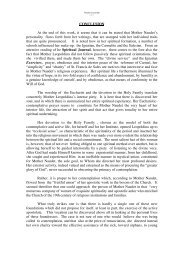

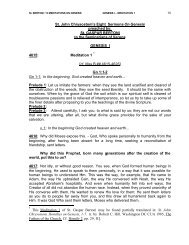
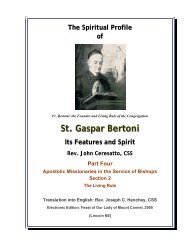

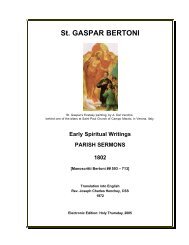
![[B.] St. IGNATIUS of LOYOLA Presentation: The ... - St. Gaspar Bertoni](https://img.yumpu.com/33393889/1/190x245/b-st-ignatius-of-loyola-presentation-the-st-gaspar-bertoni.jpg?quality=85)
